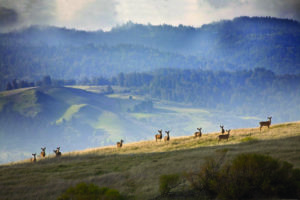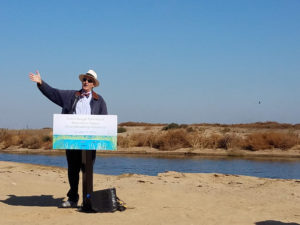East Palo Alto residents will be getting access to the San Francisco Bay for the first time with the opening of a new public park on a former toxic waste dump.
Cooley Landing Park, situated on a man-made peninsula of trash jutting out into the bay, will feature a multi-use trail and picnic areas. The 9-acre park on Bay Road will increase open space in the underserved, lower-income community by 72 percent.
“They’ve lived right on the bay all this time,” said city project manager Shannon Alford. “But they haven’t had access to it. What does it mean to live on the bay but not be able to walk up and see it?”
Cooley Landing was created as a burn dump in 1932, and rapidly grew into a peninsula of toxic waste jutting out into the bay. By 1963, the dumping and burning had come to an end, and resident Carl Schoof used Cooley Landing as a secluded location to repair boats. His boat lift still stands, and will be converted to a viewing platform.
Because of toxins in the soil, Cooley Landing won’t be safe for public access until cleanup has completed. Restoration began in November with the removal of contaminated soil and a capping of the site. Next comes the installation of a mile of trails and amenities that include picnic tables and benches. The city expects to have that work completed by the summer.
Wetland habitat will also be restored to serve as a breeding ground for clapper rail, a federally listed species of concern. The Palo Alto Baylands population is the world’s largest concentration of the chicken-sized marsh waders. The city also hopes to attract the endangered salt marsh harvest mouse.
The Cooley Landing project has been in the works for over a decade when residents got together to decide how to create more open space in a dense, urban landscape. They hope to eventually add an educational center, public access to Carl Schoof’s old house, and more trails, although those wishes have yet to be funded.
Cooley Landing Park, situated on a man-made peninsula of trash jutting out into the bay, will feature a multi-use trail and picnic areas. The 9-acre park on Bay Road will increase open space in the underserved, lower-income community by 72 percent.
“They’ve lived right on the bay all this time,” said city project manager Shannon Alford. “But they haven’t had access to it. What does it mean to live on the bay but not be able to walk up and see it?”
Cooley Landing was created as a burn dump in 1932, and rapidly grew into a peninsula of toxic waste jutting out into the bay. By 1963, the dumping and burning had come to an end, and resident Carl Schoof used Cooley Landing as a secluded location to repair boats. His boat lift still stands, and will be converted to a viewing platform.
Because of toxins in the soil, Cooley Landing won’t be safe for public access until cleanup has completed. Restoration began in November with the removal of contaminated soil and a capping of the site. Next comes the installation of a mile of trails and amenities that include picnic tables and benches. The city expects to have that work completed by the summer.
Wetland habitat will also be restored to serve as a breeding ground for clapper rail, a federally listed species of concern. The Palo Alto Baylands population is the world’s largest concentration of the chicken-sized marsh waders. The city also hopes to attract the endangered salt marsh harvest mouse.
The Cooley Landing project has been in the works for over a decade when residents got together to decide how to create more open space in a dense, urban landscape. They hope to eventually add an educational center, public access to Carl Schoof’s old house, and more trails, although those wishes have yet to be funded.
“The park is important because it’s giving people from the city the opportunity to see and interact with nature,” said Melvin Gaines, 28, a lifetime resident of East Palo Alto, who has been involved with the project.
Cooley Landing is flanked by two nature preserves. To the south is the Palo Alto Baylands and Faber-Laumeister tract, part of the Don Edwards Wildlife Refuge. To the north is the Ravenswood Open Space Preserve. Both are wetland areas that are valuable habitat for wildlife, but restricted from public access save for designated perimeter trails.
Adjacent to the site is the now-closed Romic Environmental Technologies Corp., which the U.S. Environmental Protection Agency and the city have worked to clean up after a 2006 explosion spread chemical residue over a wide swath of the baylands.
“Before we started construction the public couldn’t access Cooley Landing because there was a locked gate and all of these ‘Do Not Enter’ signs,” said Alford. “But we want to open up the space to them, give them a place where they’re encouraged to come and be here, not barred out or told to leave.”

.jpg)



